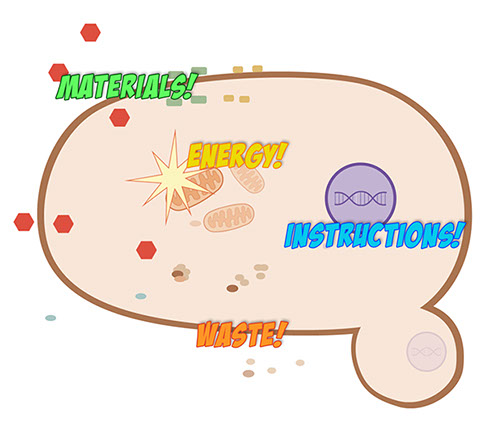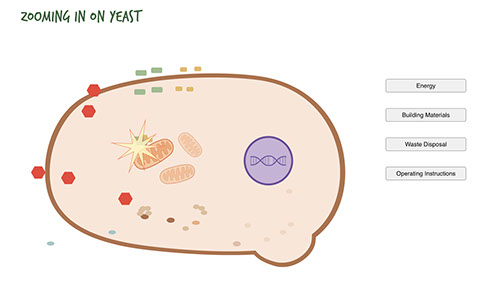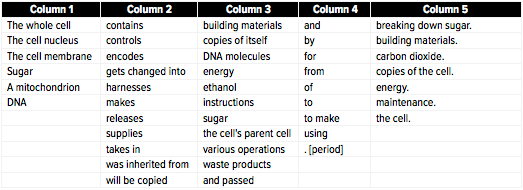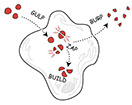SciGen Teacher Dashboard
Unit L5
The Sensational Single Cell
 Interactive: Zooming in on Yeast
Interactive: Zooming in on Yeast
Duration: Approximately 45 minutes
Discover the internal workings of a yeast cell in this simulation related to cells' four essential functions: storing and passing on operating instructions; getting energy; obtaining building materials; and disposing of waste. In this interactive animation of yeast cell, students can toggle the four basic functions on and off to see what happens.
LEARNING OBJECTIVE
Students learn a cell’s four essential functions: storing and passing on operating instructions; getting energy; obtaining building materials; and disposing of waste.
Teacher Tips
- While the model doesn't use audio, some teachers find that using headphones helps students concentrate while interacting with computers.
- Having students work in groups of 2 or 3 would work very well for this activity.
Materials (one per student or group)
- electronic device (such as a computer, laptop, or tablet) to access the cell model
Teacher Tune-ups
Teaching Notes
ACTIVITY OVERVIEW
- Review the four basic things cells do (10 minutes)
- Explore the interactive cell model (10 minutes)
- Reconstruct sentences (15 minutes)
- Review the activity (10 minutes)
Review the four basic cell functions (10 minutes)
Explore the interactive cell model (10 minutes)
Paraphrase:
What does the life of a yeast cell look like at an individual level, through a microscope? Today we will look at a visual, interactive model that shows what's happening inside a yeast cell.
This animation is a simple representation of a yeast cell that is still alive. If we were to view yeast cells under a microscope, those yeast cells would not be alive. If we were able to view live yeast under a microscope, what we'd see would be too small even at the highest magnification setting to allow us to see any parts of the yeast cells.
Explore the structures and functions of the parts of a yeast cell in the animation.
A Simpler Yeast Cell Model

Reconstruct sentences (15 minutes)
Stepping Stone Sentences
Select one word or phrase from each column to make a scientifically correct sentence. Make as many as you can by opening as many new word banks as you need!
Have students work in pairs or triads.
Reiterate the objective of the lesson and encourage the students to think about the four basic life functions when they are creating their sentences.
- Store and pass on operating instructions
- Get energy
- Obtain building materials
- Dispose of waste
To review the dense text in the labels on the animated diagram, use the DARTS instructional strategy from Reading to Learn in Science.
Directed Activities Related to Text (DARTs) are a set of during-reading strategies designed to support reflective reading. Reflective reading (as opposed to merely receptive reading) happens when a reader breaks and re-reads challenging phrases and passages, really working at understanding. Reading with a specific purpose in mind and sharing ideas in small groups can help support reflective reading.
This "Reconstruction DART" format challenges students to re-assemble segmented and disordered text.
Hint: many of the reconstructed sentences exist in the captions of the interactive cell model.
Alternate instructions: The students could come up with their own sentences before they check the interactive piece out in the previous section. Students may simply copy the captions from the interactive. This alternative allows you to check for understanding. Then, once you show the stepping stone sentences, students can return to the interactive to see if their sentences approximate those in the interactive.

Review sentences (10 minutes)
Some True Statements

Sugar gets changed into ethanol and carbon dioxide.
Sugar supplies building materials for maintenance.
The cell membrane releases waste products.
The cell membrane takes in sugar for energy.
The cell nucleus controls various operations of the cell.
The cell nucleus contains DNA molecules.
The whole cell makes copies of itself using building materials.
A mitochondrion harnesses energy by breaking down sugar.
DNA encodes instructions for the cell.
DNA was inherited from the cell's parent cell.
DNA will be copied and passed to copies of the cell.
Did you find other scientifically correct sentences? Share them and tell the class why they are valid.
After the students have spent 15 minutes generating their own sentences, take a few minutes reconstructing sentences as a class. If you are projecting on the whiteboard, you can trace lines to string the sentence parts together.
While the students may have come up with plenty of sentences, that does not mean they were all scientifically accurate. Recognize this fact to the class as you begin to record the sentences.
Intended answers are shown in this slide—but other scientifically correct sentences are certainly possible!
As you record the statements as a class, relate the statements back to the four basic cell functions.
- Store and pass on operating instructions
- Get energy
- Obtain building materials
- Dispose of waste
BETA Version - Please send comments and corrections to info@serpinstitute.org

